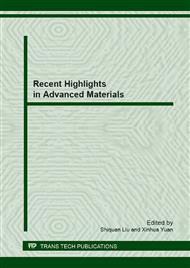p.423
p.427
p.434
p.441
p.446
p.453
p.461
p.467
p.472
Advances in Development of Titanium Alloys for Spinal Fixation Applications-Titanium Alloys with High Fatigue Strength and Low Springback for Spinal Fixation Applications-
Abstract:
The fatigue strength of the newly developed β-type titanium alloy Ti-29Nb-13Ta-4.6Zr (referred to as TNTZ) is important for its applications in spinal fixation rods. Enhancements in the fatigue strength of TNTZ upon solution treatmnet and thermo-mechanical processing (aging after severe cold-caliber rolling or sever cold-swaging) have been investigated. Aging the rods at 723 K for 259.2 ks after cold-swaging is shown to be the optimal thermo-mechanical processing method for the TNTZ rod , yeilding a high 0.2% proof stress of about 1200 MPa, high elongation of 18%, and high fatigue strength of 950 MPa. High springback is undesirable for application of TNTZ spinal-fixation rods. To reduce springback, a High Youngs modulus is required; on the other hand, a low Youngs modulus is beneficial to reduce bone absorption and obtain good bone remodeling. To achieve a balance between these two factors, TNTZ has been modified by adding Cr to obtain an alloy with a high Youngs modulus at the deformed region and a low Youngs modulus throughout the undeformed region. TNTZ-8Ti-2Cr and TNTZ-16Ti-4Cr are novel alloys whose β phase is more stable than that of TNTZ. Only the β phase is present in these alloys, which exhibit relatively low Youngs moduli of <65 GPa after solution treatment, and higher Youngs moduli after cold rolling, owing to a deformation-induced ω-phase transformation. These modified TNTZ alloys show significantly less springback than the original TNTZ, based on tensile and loadingunloading bending tests.
Info:
Periodical:
Pages:
446-452
Citation:
Online since:
September 2013
Authors:
Price:
Сopyright:
© 2014 Trans Tech Publications Ltd. All Rights Reserved
Share:
Citation:


